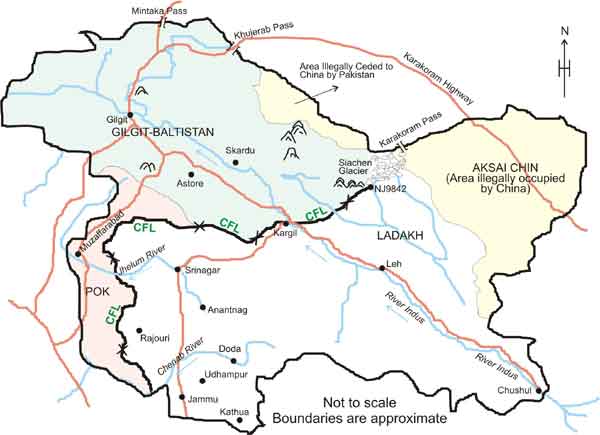IDR Blog
Gilgit Baltistan as Fifth Province: Reconciling with the Status Quo?
A high level committee in Islamabad is cogitating over a proposal to amalgamate Gilgit Baltistan as Pakistan’s fifth province. Previously referred to as Northern Areas, Gilgit Baltistan constitutes a major geographical chunk of Pakistan-occupied Kashmir (PoK). Located in a strategically pivotal positon, it serves as the only land link between Pakistan and China. Media-spurred conjectures indicate that the provincial gambit is being done at China’s behest.
Apparently, China is concerned with Gilgit Baltistan’s undetermined political status and recurrent local protests in the region for representation in Islamabad. Hence, China is keen to get rid of all roadblocks before taking the grand geo-economic plunge with an investment of $46 billion in the China Pakistan Economic Corridor (CPEC) that will connect Western China with the warm waters of the Arabian Sea via Pakistan. The CPEC package includes a string of infrastructure, power and connectivity projects lined up till the Gwadar Port in the restive province of Balochistan in Pakistan. The ongoing political contemplation within Pakistan over statutory warranty for Gilgit Baltistan is being linked to reassuring China and providing a constitutional shield to the strategic corridor worth billions.
Notwithstanding the CPEC quotient, significant inferences can be drawn from Pakistan’s bid to elevate Gilgit Baltistan as a province. Gilgit Baltistan’s absorption may signify a fundamental shift in Pakistan’s Kashmir strategy. The ‘strategic northern frontiers’ have been in a state of constitutional and political limbo since 1947, pending final settlement of the Kashmir issue. Unlike the so called Azad Jammu and Kashmir (AJK) which is governed under an interim constitution (introduced in 1974) with cosmetic state-like trappings, Gilgit Baltistan has been administered through provisional frameworks for governance introduced intermittently as stop-gap measures. The region remained disenfranchised till 2009 when the empowerment and self-rule ordinance ushered quasi popular representation, alas without representation in the National Assembly.
Alteration in Gilgit Baltistan’s political status is subject to an amendment of Pakistan’s constitution. However, any measure or amendment such as this would be in conflict with Article 257 that outlines Pakistan’s equation with parts of former princely state under its control. According to this article, Pakistan’s ties with these entities would be formalised only after they accede to Pakistan. Owing to its overwhelming Muslim majority, Gilgit Baltistan in the post-1947 era featured predominantly in Pakistan’s calculus especially in view of the UN-proposed referendum/plebiscite in Kashmir. The perennial political exclusion of Gilgit Baltistan is perceived as a significant aspect of Pakistan’s pursued agenda and broader claims on Kashmir. Therefore, the region’s incorporation as a province cannot happen without Pakistan resetting the contours of its position on Kashmir including an implied acceptance of the status quo.
During bilateral diplomatic exchanges, India and Pakistan have deliberated on retaining the status quo, i.e. converting the Line of Control into a permanent border. While India has shown its passivity over such a proposition, Pakistan has reacted sharply against it. The Musharraf formula which came close to a solution around the present ‘territorial status quo’ had failed to gather traction after his exit. Against this backdrop, Pakistan mulling over prospects of Gilgit Baltistan’s constitutional integration is a departure from its past position on Kashmir and could be construed as a kind of evolving reconciliation or rather collateral acceptance of the status quo on Kashmir.
Going by the media reports, Pakistan appears conscious of the possible fallouts of tinkering with the Kashmir wrangle. As the pre-dominant parameter, the issue has been used by Pakistan as the most effective tool against India in war and in peace. Disturbing the existing equilibrium could significantly deflate Pakistan’s Kashmir rhetoric. Likewise, the proposed move to grant constitutional status to Gilgit Baltistan is being stridently resisted along both sides of the LoC including leadership from the so called AJK and separatists in the Jammu and Kashmir State. Their reactions are underlined by apprehensions that Gilgit Baltistan’s constitutional inclusion would not only upset the Kashmir politics, but also detriment Pakistan’s case on the region formulated over the years.
The leadership in so called AJK is particularly averse to the idea as subtracting Gilgit Baltistan may circumscribe the dispute, dent their long standing ambitions and weaken their position vis-à-vis India. A similar exposition by the Hurriyat portends that the anticipated move could diminish Pakistan’s support base within the separatist constituency in India. The Hurriyat is unanimously opposed to the proposition and has conveyed its discontent to the leadership in Islamabad.
It remains to be seen on which side the camel sits. However, if the merger of Gilgit Baltistan materialises, it could potentially usher in re-orientation of Pakistan’s policy towards the Kashmir issue. As noted, multiple challenges overcast the ongoing deliberations-foremost being accommodating/retaining strategic objectives on Kashmir vis-a-vis desire to politically absorb a significant portion from it. For now, the Pakistani establishment is apparently in a huddle to carve out an innovative solution- one that could fulfil the demands of a fairly large section of the people from Gilgit Baltistan without compromising the so called ‘principled’ position on Kashmir. However, the very idea of integrating Gilgit Baltistan suggests that Pakistan to an extent might be willing to freeze territorial ambitions for now, and instead focus single-mindedly on collaborating with the Chinese led inter-continental strategic-economic drive.
All being the same regarding India’s official stance on PoK, withdrawing Gilgit Baltistan’s disputed status could reflect Pakistan’s willingness to ‘move on’ on the issue of Kashmir. In the wake of stiff popular resistance across the entire state of Jammu and Kashmir on this significant issue, Pakistan’s strategy to absorb Gilgit Baltistan may set a steady precedent and provide India with a viable fall-back option if it decides to firmly advocate full integration of the Jammu and Kashmir State into the Indian Union.
Courtesy: http://www.idsa.in/idsacomments/gilgit-baltistan-as-fifth-province_psingh_040316





